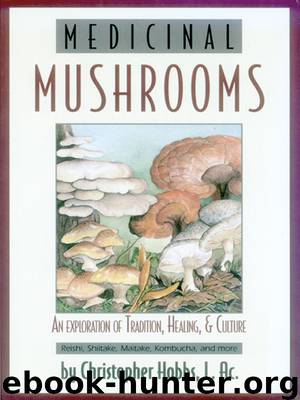Medicinal Mushrooms by Christopher Hobbs

Author:Christopher Hobbs
Language: eng
Format: epub
Publisher: Book Publishing Company
LENTINULA EDODES (BERK.) PEGLER
(lent=pliable, inus=resembling; edodes=edible)
SHIITAKE
Synonyms
Tricholomopsis edodes Sing., Lentinus edodes (Berk.) Pegler. The species name, edodes, means “edible”.
Other Common Names
The common Japanese name for L. edodes, shiitake, derives from its association with the shiia tree (Willard, 1990). Also known as snake butter, Pasania fungus, or forest mushroom (Liu and Bau, 1980) and Hua Gu in Chinese.
Description and Habitat
These light amber fungi are found on fallen broadleaf trees (Ying et al, 1987). The trees particularly suitable for growing shiitakes are chestnut, chinquapin, beech, oak, Japanese alder, sweet gum, maple, walnut, and mulberry. They have decurrent, even to ragged gills; a central to off-center stem; an inrolled margin when young; and are covered with a delicate, white flocking. They are not found in the wild in the United States but are widely cultivated. Commercial kits which allow one to grow them indoors are available, and outdoor cultivation is also possible (see resource section).
Range
L. edodes is indigenous to Japan, China, and other Asian countries with temperate climates. A very similar species occurs wild in Costa Rica (Arora, 1994).
History
Shiitake has been renowned in Japan and China as a food and medicine for thousands of years. According to historical records, in the year 199 A.D., the Japanese Emperor Chuai was offered the shiitake by the Kyusuyu, a native tribe of Japan. Even older documents record shiitake’s use in ancient China, where it was referred to as “ko-ko” or “hoang-mo” (Scientific Consulting Service).
The cultivation of shiitake is probably quite ancient. It is currently the second most commonly produced edible mushroom in the world (Nakamura, 1992). The nascent interest here has been spawned partly because shiitake tastes much more exotic and delicious than the bland Agaricus bisporus of supermarket shelves, and partly because of the immense amount of research that has been conducted on its varied medicinal properties.
Constituents
Shiitake has excellent nutritional value, containing proteins (2.22-2.60% fresh and 25.9% dry weight), lipids (primarily linoleic acid), water-soluble carbohydrates (0.45-0.72 g/100 g dry weight), total carbohydrates 67.0% (Terashita, 1990), insoluble (41.6%) and soluble (3.4%) fiber (Horie, 1991), minerals (especially calcium), and vitamins B2 and C (Liu and Bau, 1980; Ying et al, 1987). High amounts of ergosterol, a provitamin which converts to vitamin D in the presence of sunlight (Ying et al, 1987), is also present. In fact, studies have shown that exposing shiitake to direct sunlight for 3 hours/day increases its vitamin D2 content up to 5 times. Shiitake is an efficient source for this nutrient, containing between 873 and 4,381 IU/100 g of dry mushroom weight (Kobayashi, 1988; Kiribunchi, 1990; Takamura et al, 1991; Takeuchi et al, 1991). Sunlight exposure also increases the free amino acid content which is about 2,180 mg% in the dry fruiting bodies, and it makes them sweeter and less bitter (Kiribuchi, 1991).
The mineral content of cultured shiitake mycelium (on a medium of 90% bagasse, 5% rice bran, 5% wheat bran, and other nutrients) when extracted close to the fruiting stage with boiling water was as follows (in mg/g of dry weight):
Download
This site does not store any files on its server. We only index and link to content provided by other sites. Please contact the content providers to delete copyright contents if any and email us, we'll remove relevant links or contents immediately.
| Cacti & Succulents | Flowers |
| Mushrooms | Trees |
Sapiens: A Brief History of Humankind by Yuval Noah Harari(14254)
The Tidewater Tales by John Barth(12609)
Mastermind: How to Think Like Sherlock Holmes by Maria Konnikova(7228)
Do No Harm Stories of Life, Death and Brain Surgery by Henry Marsh(6891)
The Thirst by Nesbo Jo(6829)
Why We Sleep: Unlocking the Power of Sleep and Dreams by Matthew Walker(6618)
Life 3.0: Being Human in the Age of Artificial Intelligence by Tegmark Max(5475)
Sapiens by Yuval Noah Harari(5294)
The Longevity Diet by Valter Longo(5021)
The Body: A Guide for Occupants by Bill Bryson(4975)
The Rules Do Not Apply by Ariel Levy(4863)
The Immortal Life of Henrietta Lacks by Rebecca Skloot(4526)
Animal Frequency by Melissa Alvarez(4395)
Why We Sleep by Matthew Walker(4361)
The Hacking of the American Mind by Robert H. Lustig(4319)
Yoga Anatomy by Kaminoff Leslie(4306)
All Creatures Great and Small by James Herriot(4233)
Double Down (Diary of a Wimpy Kid Book 11) by Jeff Kinney(4208)
Barron's AP Biology by Goldberg M.S. Deborah T(4100)
